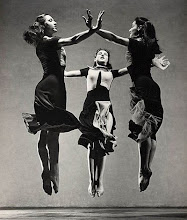excerpt taken from Empire of Ecstasy
Probably no other dancer of the era more strongly evoked an aura of
feminine innocence and geniality than Niddy Impekoven, yet she spent
much of her career struggling against efforts to mold her body according
to an image that conflicted with her desires. She was born in Berlin in
1904; her father was a prominent actor, and her family contained many
members involved in one way or another with the arts. The great moment in her education came when her father
permitted her to study for six weeks at the Loheland school in summer
of 1918; there she experienced a freedom and awareness of bodily
expression that decisively confirmed
her desire to dance.
In 1918, Niddy created her curious series of doll dances, which in addition to the "rococo" doll and the Munchener Kaffeewarmer
included miniatures inspired by the wax or porcelain figurines created
by Lotte Pritzel, Erna Pinner, and Kathe Kruse. The Erna Pinner doll
dance appeared in the film Wege zu Kraft und Schonheit (1925),
with Niddy wearing a delightful polka dot clown costume with black
stockings and gloves. She slumbered in an armchair until the twitching
of her sleep and dreams propelled her into whirling, jerky, puppetlike
movements that quickly exhausted her and caused her to fling herself
back into slumber on the chair.
Her father, however, felt the Loheland
approach lacked rigor, so she took some lessons from perhaps the most
prominent ballet master in Germany, Heinrich Kroller, who
appreciated the uniqueness of her talent. From then until 1923 she created a new program of dances every year, and
these made her an object of enormous adulation throughout Germany. Her
exquisite, nubile embodiment of fairytale feminine innocence often
provoked dark, possessive impulses in her male worshippers, and she
became eerily conscious of the power of her seemingly harmless art to
produce pathological consequences—or rather, to reveal secret conditions
of illness, remoteness from innocence, in others.
Most curious in this respect was a book about her, Briefe an eine Tanzerin (1922), written by Fred Hildenbrandt, feuilleton editor for the Berliner Tageblatt. The dances of Niddy Impekoven awakened in Hildenbrandt a rapturous,
unbridled, incoherent, even fanatical language of glorification:
She dances the breath of rapid-breathing anticipation, the play of a thousand things gleaming in the daylight, she dances the storm of tenderness, the weariness of all meanings, the blessed languor of the heart, she dances the sun, which creeps through the morning window, and she dances the early footsteps on the street which press in on her in her sleep. So she spreads in her arms, her hands, her lips and eyes the shimmering mosaic of love and no one is there who can destroy it with naked eyes. Her body is the chosen instrument of dance, the chosen instrument of love.
In 1926, John Schikowski observed that, despite their
evolution toward an 'adult' phase, Impekoven's dances were "still always
the dances of a child" and disclosed "a world of naive feelings": "This
world is small, but it is full of beauty and fairy-tale radiance. This
child gazes with large, teary, strangely shiny eyes, an aching smile on
the lips. A sick child. Even over manic exuberance a little, melancholy
cloud hovers. Poignant the droll exaltation, the grimacing gestures. Touching the little desires which strive toward
heaven, without soaring, but rather helplessly seek their chains.
Tensions and releases of a gentle, sweet softness which appears vacuous
when it does not assume a child-like style. A perfectly polished body"
In 1955 she published her brief and poignant autobiography, Die Geschichte eines Wunderkinds,
which examined her life only up to the age of fourteen and suggested
that the image of childhood innocence pervasively defining public
perception of her concealed a measure of suffering, self-sacrifice, and
anxiety that one could never really transcend and that in any case
hardly affirmed the innocence of her audience.
"My aim is constantly to distance myself from 'intellectual'
dance. . . . The purest, most natural dance is for me the unreflective
surrender to music"
-Niddy Impekoven










